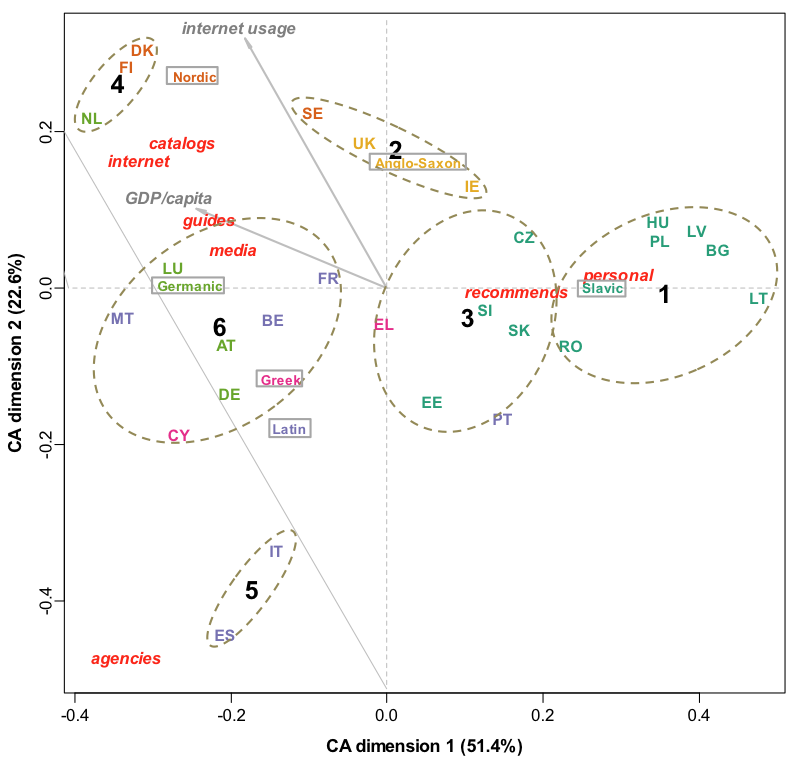Tourism in Europe is a massive industry. The ease of traveling around the continent due its good infrastructure and the relatively small distances make Europeans intense travellers. Promoting tourism destinations across countries is thus a crucial task for heating local tourism industries, but this apparently simple task is not as trivial as it seems. The Internet allows advertisers to send their messages everywhere, but what if some potential tourists do not use it when gathering information to decide their travel destination? It is not odd to think that the process of information gathering can differ quite a lot across European countries. In each country, people could use different channels to acquire knowledge about their potential travel destination.
In their BSE Working Paper (No. 915), “Information Sources Used by European Tourists: A Cross-Cultural Study,” Tor Korneliussen and Michael Greenacre analyze how Europeans’ pattern of choosing their best source of tourism information differs. By aggregating the unit of observation on 27 European countries, they identify systematic differences in how potential travellers inform themselves when making their travel or holidays plans. Their results are very relevant from a descriptive point of view, but also from a policy implementation point of view: it allows for tailoring tourism marketing strategies to each market or country in order to make advertising efforts more effective and efficient.
Identifying systemic cultural segments for travel planning
The objective of their study is to find systematic segments of information sources across Europe. To do so, they must segment the continent into units that have some fair degree of homogeneity towards tourism behavior. They decide to use the country unit: within it people must have similar degree of income and culture, which can reflect a common pattern of tourism demand.
The sample used is the Eurobarometer survey, whose data specifies the preferred information source in each country. The survey asks respondents to choose the most important information source when making travel plans:
- personal experience
- recommendations
- guidebooks
- catalogues
- Internet travel agencies
- the media
These data show a remarkable degree of heterogeneity across countries, corroborating the authors’ initial idea of differentiation of information sources across Europe.
Using correspondence analysis to plot travel planning preferences
The novelty of this study relies on a statistical technique used to group countries within dimensions of the most preferred source, called correspondence analysis. First, the authors define two dimensions:
- professional information sources (travel agencies against personal experience)
- personal information sources (travel agencies against Internet)
The statistical tool mentioned then ‘plots’ the countries depending on preferred information sources as defined on the two dimensions. Simply illustrated, a country that uses more Internet rather than travel agencies, but also gives weight to personal experiences and recommendations, will be placed in the right upper quadrant of the plot. (This is a very simplified example for illustration, as the dimensions consider the seven categories of the survey.)
The results of the authors’ analysis can be seen in Figure 1. An interesting fact is that countries are somehow grouped with respect to their preferred information source in six groups, and each of these groups includes very similar countries. The figure also shows a color coding according to six groups of national culture (the average of a culture group is shown in a box), which are seen to correlate quite well with the six clusters based on primary information source (numbered 1 to 6 and enclosed by ellipses).

Most importantly, the dimensions defined by the authors show clearly some segmentation of countries within Europe. For instance, there is a clear difference between Eastern and Western countries along the professional dimension (horizontal axis): in Figure 1 it is possible to see that Group 6 (which includes France, Germany, Belgium, and Austria, among others) tends to use much more professional information, whereas Group 1 (including Hungary, Bulgaria, and Lithuania, among others) apparently uses it much less. On the other hand, the personal dimension (vertical axis) splits Northern to Southern countries. Group 4 (Denmark, Finland and The Netherlands), for instance, seems to seek information much more from non-personal sources than Italy and Spain (Group 5). The latter seems to rely far more on personal sources.
Can travel planning be related to a country’s characteristics?
A very interesting observation the authors make is the relation of such differences with country-specific characteristics as GDP per capita and Internet penetration. Indeed, those countries with higher GDP per capita seem to use more non-personal sources, which can be explained by their higher income and the capacity of their people to choose places that are farther away as their holiday destination. Moreover, having more Internet access can also encourage individuals to search for information outside the professional dimension. In Figure 1, Internet usage and GDP/capita ‘move’ countries towards the top-left quadrant – to a more professional and non-personal behavior of choosing the travel information source.
In conclusion, the work by Tor Korneliussen and Michael Greenacre applies a novel statistical approach that segments the European tourism markets in clusters of information sources used to decide travel destinations. The clusters show a high degree of similarity, which supports the authors’ idea of national culture as a determinant of the travel behaviour of individuals. Despite the clear potential policy implementation results, the authors suggest that a further segmentation of the ‘cultures’ within each country – that is, in countries’ regions – could enrich the study even further and allow for even more detailed results of the behavior of Europeans when gathering information for their travel plans.


